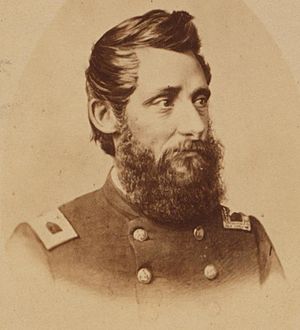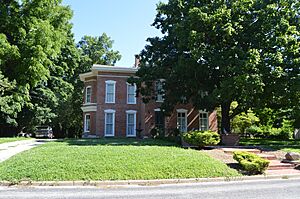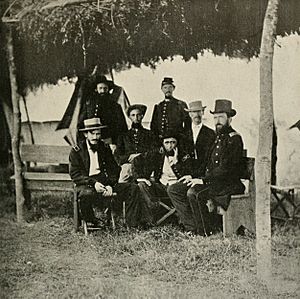Benjamin Grierson facts for kids
Quick facts for kids
Benjamin Henry Grierson
|
|
|---|---|

Benjamin H. Grierson
|
|
| Born | July 8, 1826 Pittsburgh, Pennsylvania |
| Died | August 31, 1911 (aged 85) Omena, Michigan |
| Place of burial | |
| Allegiance | United States of America Union |
| Service/ |
United States Army Union Army |
| Years of service | 1861–1890 |
| Rank | |
| Commands held | 6th Illinois Cavalry 10th U.S. Cavalry Department of Arizona |
| Battles/wars | American Civil War Indian Wars |
Benjamin Henry Grierson (born July 8, 1826 – died August 31, 1911) was an important figure in American history. He started as a music teacher. Later, he became a skilled officer in the United States Army. During the American Civil War, he served as a cavalry general for the Union Army. After the war, he continued to lead troops in the American Old West.
Grierson is best known for Grierson's Raid. This was a daring mission in 1863. His troops rode deep into enemy territory. They cut off important communication lines. This helped the Union forces during the Vicksburg Campaign. After the war, he also helped create and lead the Buffalo Soldiers. These were African-American soldiers in the 10th Cavalry Regiment. He commanded them from 1866 to 1890.
Contents
Early Life and Overcoming Challenges
Benjamin Grierson was born in Allegheny, Pennsylvania. This area is now part of Pittsburgh. He was the youngest of five children. When he was eight years old, a horse kicked him. This accident made him very afraid of horses. It's amazing that he later became a famous cavalry commander!
In 1851, Grierson became a music teacher. He also led a band in Jacksonville, Illinois. He married Alice Kirk in 1854. They had seven children together. Four of their children lived to be adults.
Serving in the Civil War
When the Civil War began, Grierson joined the army. He started as a volunteer helper to Maj. Gen. Benjamin M. Prentiss. In October 1861, he became a major. He joined the 6th Illinois Cavalry. By April 1862, he was promoted to Colonel of this regiment.
His regiment took part in many small battles. They also raided railroads and other enemy sites. This happened in Tennessee and Mississippi. In November, he became a brigade commander. He was part of the Cavalry Division. In December, he chased Confederate General Earl Van Dorn. Van Dorn had raided Union supply lines.
Grierson's Famous Raid
In the spring of 1863, Grierson led his most famous mission. It was called Grierson's Raid. General Ulysses S. Grant ordered this raid. It was a distraction for the Vicksburg Campaign. Grierson left La Grange, Tennessee, on April 17. He commanded 1,700 cavalry soldiers.
For 17 days, his troops rode 800 miles. They fought Confederate soldiers many times. They also damaged two railroads. They captured many prisoners and horses. They destroyed a lot of enemy property. The raid ended in Baton Rouge on May 2. This raid scared many people in the South. It also confused the Confederate forces.
Most importantly, Grierson's raid pulled Confederate attention away. This allowed General Grant to move his main forces. General William Tecumseh Sherman called it "the most brilliant expedition of the war." Grierson was promoted to brigadier general in June.
Later Civil War Actions
In June 1864, Grierson led a cavalry division again. This was during William T. Sherman's Meridian Campaign. He also fought against General Nathan B. Forrest. This was at the Battle of Brice's Crossroads. Grierson later commanded cavalry in West Tennessee. He fought Forrest again at the Battle of Tupelo and did much better.
From December 1864 to January 1865, Grierson led another mission. He attacked the Mobile and Ohio Railroad. On Christmas Day, he surprised Forrest's camp. He captured over 500 enemy soldiers. For this success, Grierson was promoted to brevet major general. In the spring of 1865, he helped capture Mobile, Alabama.
Service in the American West
After the war, Grierson stayed in the Regular Army. He became a colonel. He helped create the 10th U.S. Cavalry. This was one of the first regiments of Buffalo Soldiers. These units had African-American enlisted men and white officers.
Grierson was very supportive of his troops. This made some other officers dislike him. He also treated Native American tribes with respect. This sometimes led to questions about his decisions. A documentary called "Buffalo Soldiers" noted his strong support for his unit. It said he believed in their abilities and dedication.
Key Commands and Achievements in the West
- 1867–69: He commanded Fort Riley and later Fort Gibson.
- 1868–69: He led the District of the Indian Territory.
- 1869–72: Grierson chose the location for Camp Wichita. This camp later became Fort Sill, Oklahoma. He oversaw its building and was its first commander. He supported peace with the Kiowa-Comanche Reservation. He even saved General William Tecumseh Sherman's life. This happened during a tense meeting with Lone Wolf, a Kiowa chief.
- 1875–78: He was the commander at Fort Concho, Texas.
- 1878–80: He commanded the District of the Pecos. In 1880, he helped defeat Victorio. This ended the Native American threat in West Texas.
- 1886–88: He commanded the District of New Mexico. Here, he worked well with the Jicarilla and Navajo reservations. He handled their problems with understanding.
- April 5, 1890: He was promoted to Brigadier General.
- July 8, 1890: He retired from the army.
Grierson's first wife, Alice, died in 1888. He later married Lillian Atwood King in 1897. He had homes in Jacksonville, Illinois, Fort Concho, and a summer home in Omena, Michigan. In 1907, he had a stroke. He passed away on August 31, 1911, in Omena. He is buried in Jacksonville East Cemetery in Illinois.
Grierson in Media
Colonel Grierson is featured in the Turner Network Television documentary, "Buffalo Soldiers".
The character of Colonel Marlowe, played by John Wayne, in the movie The Horse Soldiers is based on Grierson.



